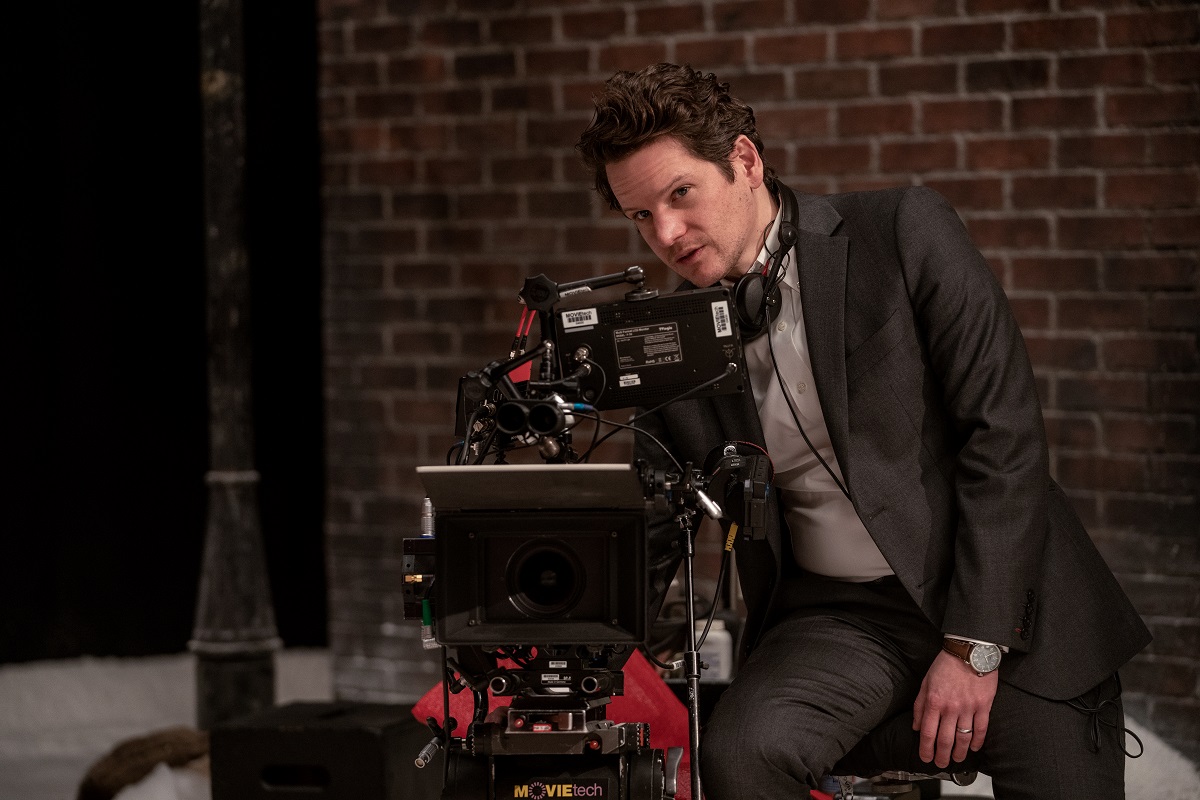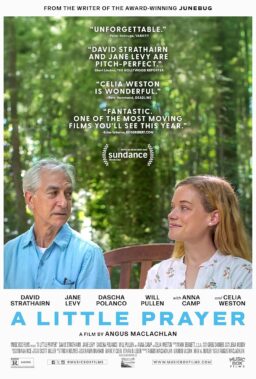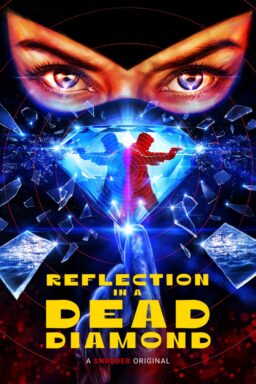“The Outfit” is a tense, one-room thriller co-written by Oscar-winner Graham Moore (“The Imitation Game”), who also directed—his first feature as a director. He told me that the inspiration came from two sources. First was his grandfather, a doctor he described as the kindest man he has ever known. One of the doctor’s patients was a notorious gangster. When asked about it, his grandfather shrugged, saying “He was always a gentleman to me.” The other idea came from Moore’s co-screenwriter, Johnathan McClain, who suggested a movie about a Savile Row tailor. In doing their research, they discovered that the very first bug placed by the FBI, when the recording technology made that possible, was in a tailor shop. That was enough to create a storyline about a gentle tailor with a mobster client. In our interview, he also told me about getting the right Chicago accents for his cast, the advantages and disadvantages of a one-set story, and why the most expensive shot in the film is just a man smoking a cigarette.
As a Chicagoan, I was impressed with the Chicago accents of your cast, many of whom are British.
The cast ended up being this interesting combination of American actors and English actors. And so, everyone getting a Chicago accent was extremely important to me. We had a wonderful dialect coach named Kate DeVore, who is the house dialect coach at the Steppenwolf Theatre in Chicago, which I used to walk to from my mom’s house when I was a kid. The first time I ever saw a David Mamet play was at Steppenwolf, and so many other plays there that meant so much to me. It was right in the middle of COVID so there weren’t any plays going up at Steppenwolf that month. Kate was very available to Zoom with all the cast. And she was right in Chicago, and from there. She was so wonderful with them.
It was important to me that they all shared a dialect coach, someone we could all work with. And something I think I really like about Kate and her approach to it was not smoothing out the accents, they should not all sound identical. The characters are individuals, from different parts of the city. They’re all from different parts of Chicago. There are lots of subtle differences there. They don’t all sound like they’re doing “the Chicago accent” that I’m putting in quotes with my fingers right now. Though it was hard I think with Zoey Deutch’s character, Mable, in particular. I remember Zoey and Kate both asked me how I thought she sounded, how I wanted the character to sound. And I remember saying, “Can she just sound exactly like my sister?” Because I’m from Chicago, and that’s how I’ve heard her this entire time. But we found something a bit more period appropriate.

I would figure that Mable was aspirational, and therefore would try to hone her accent a little bit.
That’s exactly right. You’ve seen her performance, that it gets a little bit, some of the Chicago-ness comes off a little bit more when she’s scared, when she gets nervous and she’s trying to hide, you see it a little bit more. But she’s also a little bit younger than the other characters, so there are modernizing touches. She’s trying desperately to get out of Chicago. So there’s this kind of worldliness to her accent. And we talked a lot about what are the records that she listens to? What are the images of the world outside of Chicago she’s seen? What are the movies she’s seen? Why does she want to leave so much? What is her idea about what the world outside of this place looks like?
Similarly, Mark Rylance is playing an Englishman but he is so precise with language that his accent is actually very specific. He found these tapes of this guy who was born in exactly the same year we said that his character was born in, in the exact same area south of London. And he found this interview with this guy just describing going about his day. Mark would have these tapes on set every day and would listen to them often between setups and between takes to hone the accent. I think we associate Mark with English accents but we don’t notice how specifically modulating it is. It is, in fact, quite precise after months and months of work on his part.
Tools are very important in the movie, and people talk about their tools. Is there a tool that’s particularly important to you?
What I found as a first-time director on a film set, which was sometimes bizarre and difficult, was that no one lets me touch the tools. I’m not allowed. Due to union rules, I’m literally not allowed to touch the camera. I don’t dare touch a light because if I do I’m going to break something. It’s funny thinking about it because there are so many fun tools that go into the filmmaking process. And part of my job was to realize that I knew less about the exact use of each and every one of those tools than the respective brilliant craftspeople in the different departments who help to use them. I remember I had a friend who said to me when we were shooting, “So do you feel this power now? Do you feel like you’re in control?” And I said, “No, just the opposite. I’ve never had less control in my life.” It’s actually a fascinating helplessness in getting to rely on so many experts.
Wardrobe, of course, is very important in this movie, starting with the title of the film. And you had two costume designers, one a fashion icon who has not worked in film before, Zac Posen.
Obviously, this is a film about a tailor, or, as he would put it, a cutter, so the costumes in the film are all serving a huge narrative purpose for a number of reasons. Principally, that many of them were actually built by Mark’s character. When Dylan O’Brien enters, or when Simon Russell Beale who plays Roy enters, those are suits that Mark’s character is supposed to have made. They need to look as good as we’re saying he is at the skill. So, my designers, Zac Posen and Sophie O’Neill, worked with a Savile Row shop called Huntsman to help make these clothes.
Zac and Sophie were a great combination. Because Zac is obviously a very revered clothing designer himself. Zac is like a one-man encyclopedia of clothing history. He had read early scripts and was giving notes and was correcting all of my mistakes. “He would never iron a jacket with that kind of iron. This is the iron you use.” I mean, that’s the extent of Zac’s knowledge of the history of the material.
And then Sophie is a brilliant young designer who’s just really experienced in films. Zac hadn’t worked on the film before, despite all of his great fashion credits. Sophie has done lots and lots of films and could be there with us really making everything run smoothly and work perfectly on set.
We knew we wanted to work with real Savile Row tailors to build all these clothes. For the same reason, Mark Rylance trained extensively with those tailors. Mark actually got to train on his own costume for the movie. The suit that Mark learned how to make in his training was the suit that he then wore as his costume for the film.
It’s also a movie where, because everything takes place on this one set, characters come through the door, and we learn so much about them by what they’re wearing. In a more typical film, we could see their homes, we could see their cars, we could see their morning routines. We don’t have any of that in this film. We only see how they present themselves when they walk through the door. Which means that every little detail of everyone’s collar and the different knots on the ties tells the audience a tremendous amount about who they are, about what they care about, about what they don’t care about.
It’s called “The Outfit.” It’s about someone who makes clothes. And this kind of metaphor of clothes making was so important to us because every character has all these layers to them. Over the course of the film, every character is metaphorically and in some cases literally removing layers of their clothing to reveal more and more about him or herself over the course of the story. And so we spent a lot of time preparing and designing and really crafting distinct clothes for each character that would, in some sense, tell you all you need to know about who they were and what was really important to them.

What are the advantages and the disadvantages of having all the action in one room?
We talked a lot about this as being kind of tradition of single location cinema from “12 Angry Men” through Hitchcock’s “Rope” and “Lifeboat.” If you’re looking for guidance about the best places to hide a body on a set, you can do a lot worse than going to “Rope” for guidance.
We really didn’t want the single location conceit to be a kind of film school gimmick. The idea of it was that Leonard, Mark Rylance’s character, never leaves the shop over the course of the film, and we want to be inside his head. We want to see what he sees, we want to hear what he hears, we want to go where he goes, and he doesn’t go anywhere besides the shop. So, the camera should never go anywhere besides the shop. That created all sorts of interesting challenges photographically because there were lots of bits of cinematic language that we just then didn’t have access to. The most basic example is establishing shots in this traditional sense. We can’t cut to the sun rising over the Chicago skyline to tell the audience that now it’s the next morning. We have to communicate the passage of time through other ways.
Actually, if there was one thing that I think our brilliant cinematographer Dick Pope and I spent more time talking about than anything else in our prep period, it was how we communicate passage of time. If we don’t want to put to a clock on the wall or something stupid, how do we communicate the passage of time using the cinematic tools that we have in front of us?
On another level though, I think having the entire film be on this one set gave us a lot of advantages. We would ask: how do we make it not a constraint but instead an advantage? What can we do that a more traditional film couldn’t do? Well, one thing we could do is shoot entirely in order. Because we were only on the one set, there was no cost efficiency to be gained by shooting the scenes out of order. So, once we hit on that very early, Mark got excited, the other actors got excited, everyone was really game to shoot a film entirely in order because none of us had ever done something like that before. And that actually allowed us to play and experiment in interesting ways that we might not have been able to otherwise. If Mark did something in an improv in scene 10, we weren’t already locked into something for scene 11 that we’d shot the week before. We could just go change it and deal with it.
And then likewise, it meant that all the kind of care and obsession towards detail that on a more traditional film we would have devoted to 20 sets or 30 sets, we got to devote to exactly one set with our wonderful production designer, Gemma Jackson, who’s a genius. It had to be shot on a soundstage because we needed to be able to completely control and meticulously design the space from the floor to the ceiling. Everything is purposeful. Everything is designed around how we want to move the camera; the space is being designed to allow specific shots to happen.
But again, also because of the contained nature of things, we had this rehearsal period with the cast before we started shooting. So, I would be upstairs in a rehearsal room with the cast while the set was being painted downstairs, and then at five o’clock, usually the painters would be finished, and I could bring the cast down to the set, and we could we start playing around. And so, Mark’s character is supposed to know the space like the back of his hand. So, one: that helped him to actually know the space like the back of his hand. But then, two: if he was doing something in a rehearsal that seemed interesting but wouldn’t quite fit with the space, we could just change the space. I mean, he had spent so much time training with tailors.
I actually remember the first time he saw that big work table in the back room. Mark comes over and takes some fabric and some shears and starts standing in front of it, is this going to work. And the first thing he said was, “It’s an inch too high.” And I brought over some of our lighting technicians. And they said, “Oh, yes, we had to raise it a little bit because the lights and this and that.” And Mark said, “No, no. It has to be an inch lower. I trained. I know how to do this. This wouldn’t be so high. You have to lower it.” And he was absolutely right. And we did and we made it work with the lights. And that was the sort of obsessive attention to detail that both Mark’s character got to experience and Mark as an actor performs with every day.

You took a risk with some shots in the film that were not from Leonard’s point of view. They were brief but they were theatrical, and I thought they worked very well.
We went into this movie with a set of very strong aesthetic principles. It’s a film about a main character who has his own set of aesthetics. Leonard makes clothes, so the whole film should look and feel like his clothes. It should look and feel like Leonard made it. The camera, the sound department, the music, we should all sort of abide by Leonard’s aesthetic principles. Then we had to figure out okay, so what are those principles? What are the things we can’t do? What are the things we should do a lot of? And so, that meant some things like never using handheld cameras. The camera actually moves a lot. It’s not static, we are always moving it, but it’s always on wheels. Every motion of the camera is extremely precise and planned out.
We wanted it to feel very natural, human, classic in this kind of Hitchcockian way. The camera always moves with the bodies of characters, it always moves as they move, the speed that they move, it uses bodies to guide its motion like a set of clothes would.
At the same time, we wanted these little changes to signal to the audience that perspective shifts are coming. The movie is really interested in perspective, and whose perspective you’re getting different scenes from. There’s exactly one moment where the camera rises above Mark Rylance’s head level and goes up towards the ceiling. It was important to have it not feel kind of flashy because Leonard’s clothes aren’t flashy, they’re not trying to take your eye away. It was our most expensive shot because we used a crane. Our running joke was always that our one big expensive crane shot on this film is for a wordless moment of Mark Rylance just smoking quietly. That is the most “The Outfit” thing, hiring this big crane and having it rise to the ceiling just to shoot Mark quietly smoking. But we were trying to tell the audience, “Your perspective is about to shift.” You’ve been seeing the story from one perspective, and now we’re actually telling you that the perspective you’ve been seeing it from is not the full story. And so, every time we would do that, little tricks like that, these little moments where the camera would take a God point of view so to speak, they would leave the perspective of a character just for a shot to start to signify that a new perspective is about to enter the story.
How do you work with an ensemble that includes classically trained British actors and Americans who do not come from that background?
I have never met two actors who work the same way. I’ve never met two actors who have the same process. Everyone in this film is an actor whose work I really liked before. I found that it was not my job to go to them and say, “Hey, here’s how I want to do things.” But rather, it’s my job to go to them and say, “Hey, can you tell me under what conditions you feel you do your best work? And how can I create those conditions for you? Are there things that if I do you’ll hate it and I should try to avoid doing them the best that I can? Are there things that you love? Is there something you’ve always loved, are there conditions under which you love to work that you haven’t gotten the chance to have before?” I felt like so much of my job was to create an environment and a set of conditions in which everyone else could do his or her best work.












